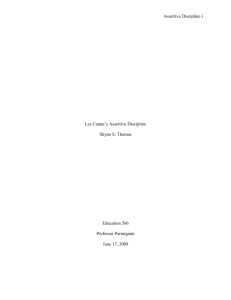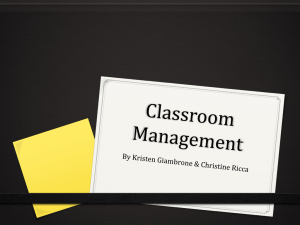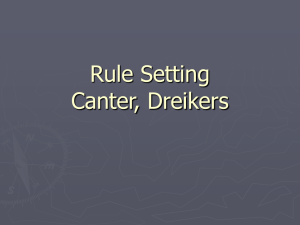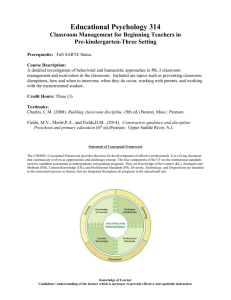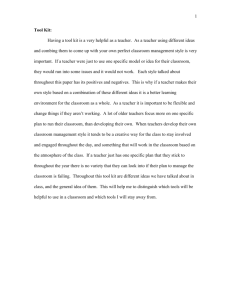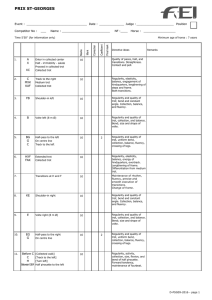matheny_philosophyofclassroommanagement
advertisement
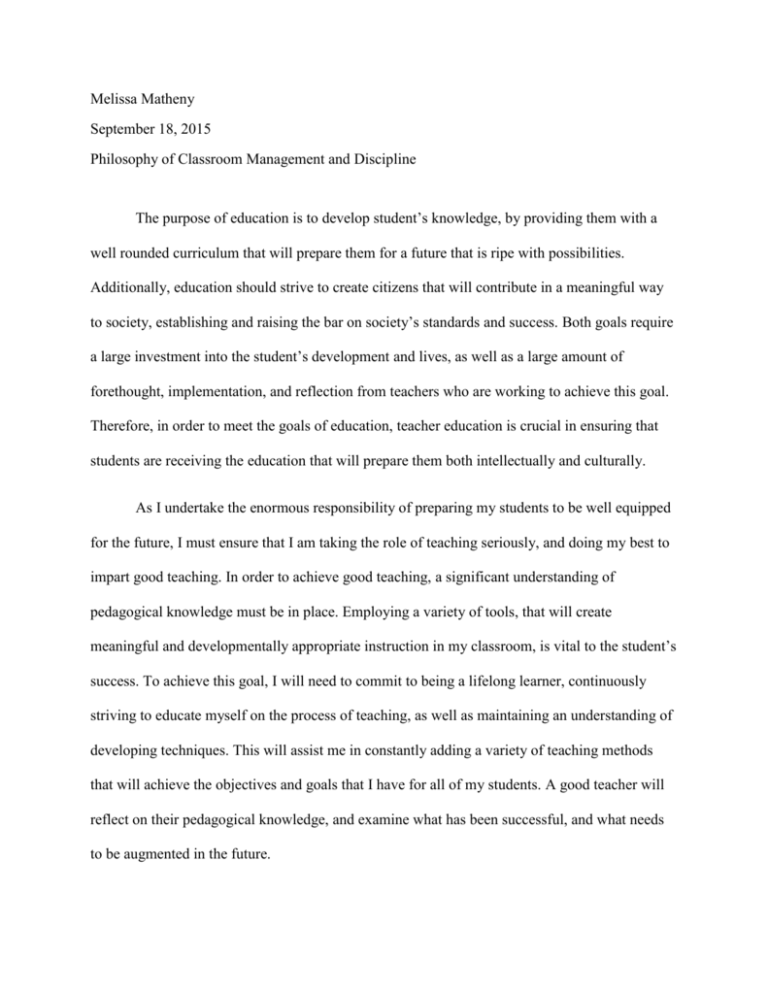
Melissa Matheny September 18, 2015 Philosophy of Classroom Management and Discipline The purpose of education is to develop student’s knowledge, by providing them with a well rounded curriculum that will prepare them for a future that is ripe with possibilities. Additionally, education should strive to create citizens that will contribute in a meaningful way to society, establishing and raising the bar on society’s standards and success. Both goals require a large investment into the student’s development and lives, as well as a large amount of forethought, implementation, and reflection from teachers who are working to achieve this goal. Therefore, in order to meet the goals of education, teacher education is crucial in ensuring that students are receiving the education that will prepare them both intellectually and culturally. As I undertake the enormous responsibility of preparing my students to be well equipped for the future, I must ensure that I am taking the role of teaching seriously, and doing my best to impart good teaching. In order to achieve good teaching, a significant understanding of pedagogical knowledge must be in place. Employing a variety of tools, that will create meaningful and developmentally appropriate instruction in my classroom, is vital to the student’s success. To achieve this goal, I will need to commit to being a lifelong learner, continuously striving to educate myself on the process of teaching, as well as maintaining an understanding of developing techniques. This will assist me in constantly adding a variety of teaching methods that will achieve the objectives and goals that I have for all of my students. A good teacher will reflect on their pedagogical knowledge, and examine what has been successful, and what needs to be augmented in the future. Good teaching is vital to cognitive development, but in order to develop good citizens, the classroom needs a good teacher. I cannot expect to improve student learning through teaching methods alone. As a teacher, I will be a role model for the behavior and characteristics that I want to see in my students. Therefore, I will try to demonstrate the types of attributes that I want to see in my students. Through my actions towards my students, I will show them to be respectful, reliable, and trustworthy. I will strive to be judicious without stifling creativity and inspiration. I will maintain a systematic classroom, while aiming to be flexible to accommodate for the unpredictable. Patient as students go through their own learning process, while representing an enthusiasm for learning. I aspire to encompass these character traits, however; a good teacher has a classroom management plan that will structure the classroom, and provide guidelines that will assist the students in understanding what is expected. The goals of a classroom management plan are to set in place rules and remediation that provide a classroom environment that promotes safety, equality, and maximizes instructional time. To meet these goals, I would align my classroom management plan with the Assertive Discipline model, created by Lee and Marlene Canter. In this model there is a high level of teacher control to maintain structure. This in turn, provides a classroom in which students are aware of their expectations. Conversely, student control is low, but gradually increases as the year progresses and the classroom procedures are well known and followed. The Assertive Discipline model has a few specific strategies that appealed to me. Teacher control is gained by establishing and teaching a “specific discipline plan” (Canter, 1993). During this time, the teacher not only establishes the rules, but explains the reasoning behind them, checks the student’s understanding, and repeats the process through role playing, and group discussion until the discipline plan is well established Although the classroom structure is set in place by the teacher, the teacher also maintains a classroom that values student’s personal needs and interests. This model encourages the teacher to take an interest in each student individually, and model respect and positive support towards their students (Canter, 1993). By interacting with each student individually, celebrating their personal accomplishments and events in their life, the teacher can begin to know each student, and work towards meeting their needs. This helps to prevent misbehavior before it can begin. In this way, the model works toward using “positive support” by utilizing “verbal recognition” (Canter, 1993). This is accomplished by using genuine and descriptive praise when a student’s behavior is aligning with the goals of the classroom. However, in the event that students are not demonstrating the desired behavior, verbal recognition can be used to praise students who are on task while letting the students who are not on task know that you are aware of their behavior. Additionally, physical proximity can be utilized to discourage disruptive student behavior (Canter, 1993). When situations arise in which a student is consistently displaying disruptive or negative behavior, the model focuses on the teacher working to provide the environment that is necessary for this student. This is achieved by following the steps of “reaching out to the student, meeting the student’s needs, and communicating with the student (Canter, 1993). While ensuring the safety and structure of all students, the teacher should calmly enforce corrective actions outlined in the specific discipline model, but ultimately focus on finding a way to successfully connect and communicate with the student. As I begin to teach there will be many considerations to make in regards to classroom management. Each class will be composed of individuals who learn in a myriad of ways, and require specific teaching and interpersonal methods. However, the Assertive Discipline model allows for the teacher to alter their classroom to meet the needs of each individual student, while still maintaining classroom structure that will provide guidelines for the students to follow. Additionally, the high level of respect that the teacher models toward each member of the class aligns with my personal goals for teaching, and allows me to model characteristics that will achieve the goal of producing students who are not only educationally prepared for the future, but also exceptional citizens. Works cited Canter, L., and Canter, M. 1993. Succeeding with difficult students: New strategies for reaching your most challenging students. Santa Monica, CA: Lee Canter & Associates.
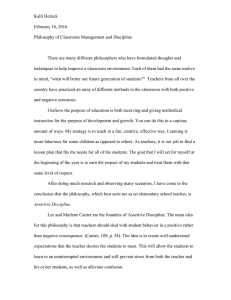
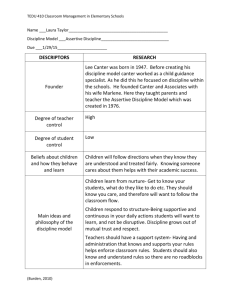

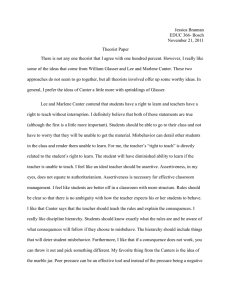
![Assertive_Discipline[1][1]](http://s2.studylib.net/store/data/010086441_1-ea90dcc592ac7f410481d0652d96c6e6-300x300.png)
